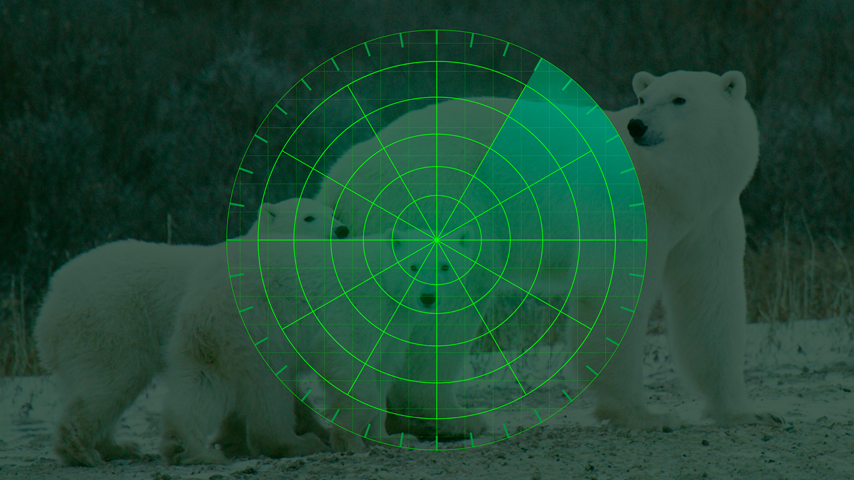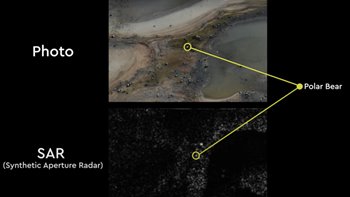Engineers Spot Polar Bear Dens Via Radar
Engineers Spot Polar Bear Dens Via Radar


A research team has developed a means for finding polar bear dens using a synthetic aperture radar system flown aboard an aircraft.
Winter is a critical time for polar bears. In their dens, mothers nurse young cubs, and if they are disturbed, the mother and the cubs may not survive.
For researchers who are working to get accurate counts of these endangered creatures, detecting the dens from a safe distance is crucial. But the current methods for finding dens are faulty. According to a 2020 study conducted by Polar Bears International, researchers miss more than half of known dens.
A collaboration among Simon Fraser University, Brigham Young University, and Polar Bears International has set out to improve on those numbers. They have developed a means for finding polar bear dens by using a synthetic aperture radar (SAR) system flown aboard an aircraft.
A pilot study of the system in northern Manitoba found that SAR increased the number of dens detected by 20 percentage points. The work was reported in the journal, Ursus.
BYU students designed the experiment using a SAR from ARTEMIS, a company in Hauppauge, N.Y. “They agreed to help us with this project by supplying the radar systems and assistance in processing the images,” said David Long, director of BYU’s Center for Remote Sensing.
The idea was that because SAR can see beyond weather conditions like fog and snow and can operate at night, it would be much more effective than other technologies such as infrared at locating the bears.
“The SAR radar signal reflects differentially the polar bear versus the surrounding terrain,” Long said. “We get a much brighter return for the polar bears than we would using infrared.”
Long explained that for a prototype experiment the results are good, and with more time and better equipment, he believes the team can refine the system to be even more effective.
More Like This: Simple, Sophisticated Sensing Systems Collect Critical Information
One way the team hopes to develop the design further is by using drones instead of an aircraft. However, that could pose a threat to the bears as the sound of the drones flying so close to the dens might disturb them.
A more sophisticated radar that will allow researchers to test with multiple frequencies would provide data at different penetration depths that may more precisely reveal bears in their dens.
“The frequency used for the radar affects the signal you'll get back,” Long said. “Low frequencies can see deep into the snow. Higher frequencies don't see as deeply, but have more available bandwidth, allowing us to get better pictures. By using multiple frequencies, we think we can get the advantages and strengths of both capabilities for more precise results.”
Electronic Detection: LIDAR for Remote Sensing During COVID-19
Overall, this experiment was a special opportunity for the multidisciplinary team of students, Long said, who explained that the students are a mix of mechanical, electrical, and computer engineers.
“The students not only had to learn how to use the radar but develop plans for how to fly past the dens,” he said. “They also learned how to process the data and how to use different techniques. This was all an exciting experience for them to also learn about polar bear lifecycles. It's really kind of fun. You don't normally expect undergraduates to publish a real-life journal paper from their work.”
Cassandra Kelly is a technology writer in Columbus, Ohio.
For researchers who are working to get accurate counts of these endangered creatures, detecting the dens from a safe distance is crucial. But the current methods for finding dens are faulty. According to a 2020 study conducted by Polar Bears International, researchers miss more than half of known dens.
A collaboration among Simon Fraser University, Brigham Young University, and Polar Bears International has set out to improve on those numbers. They have developed a means for finding polar bear dens by using a synthetic aperture radar (SAR) system flown aboard an aircraft.
A pilot study of the system in northern Manitoba found that SAR increased the number of dens detected by 20 percentage points. The work was reported in the journal, Ursus.
BYU students designed the experiment using a SAR from ARTEMIS, a company in Hauppauge, N.Y. “They agreed to help us with this project by supplying the radar systems and assistance in processing the images,” said David Long, director of BYU’s Center for Remote Sensing.
The idea was that because SAR can see beyond weather conditions like fog and snow and can operate at night, it would be much more effective than other technologies such as infrared at locating the bears.
“The SAR radar signal reflects differentially the polar bear versus the surrounding terrain,” Long said. “We get a much brighter return for the polar bears than we would using infrared.”
Successful spotting
The team worked with a local pilot by rigging a small aircraft with the SAR system. The pilot then took several passes over a swatch of land known to have dens. After analyzing the data, the students successfully located two-thirds of the known dens.Long explained that for a prototype experiment the results are good, and with more time and better equipment, he believes the team can refine the system to be even more effective.
More Like This: Simple, Sophisticated Sensing Systems Collect Critical Information
One way the team hopes to develop the design further is by using drones instead of an aircraft. However, that could pose a threat to the bears as the sound of the drones flying so close to the dens might disturb them.
A more sophisticated radar that will allow researchers to test with multiple frequencies would provide data at different penetration depths that may more precisely reveal bears in their dens.
“The frequency used for the radar affects the signal you'll get back,” Long said. “Low frequencies can see deep into the snow. Higher frequencies don't see as deeply, but have more available bandwidth, allowing us to get better pictures. By using multiple frequencies, we think we can get the advantages and strengths of both capabilities for more precise results.”
Electronic Detection: LIDAR for Remote Sensing During COVID-19
Overall, this experiment was a special opportunity for the multidisciplinary team of students, Long said, who explained that the students are a mix of mechanical, electrical, and computer engineers.
“The students not only had to learn how to use the radar but develop plans for how to fly past the dens,” he said. “They also learned how to process the data and how to use different techniques. This was all an exciting experience for them to also learn about polar bear lifecycles. It's really kind of fun. You don't normally expect undergraduates to publish a real-life journal paper from their work.”
Cassandra Kelly is a technology writer in Columbus, Ohio.




